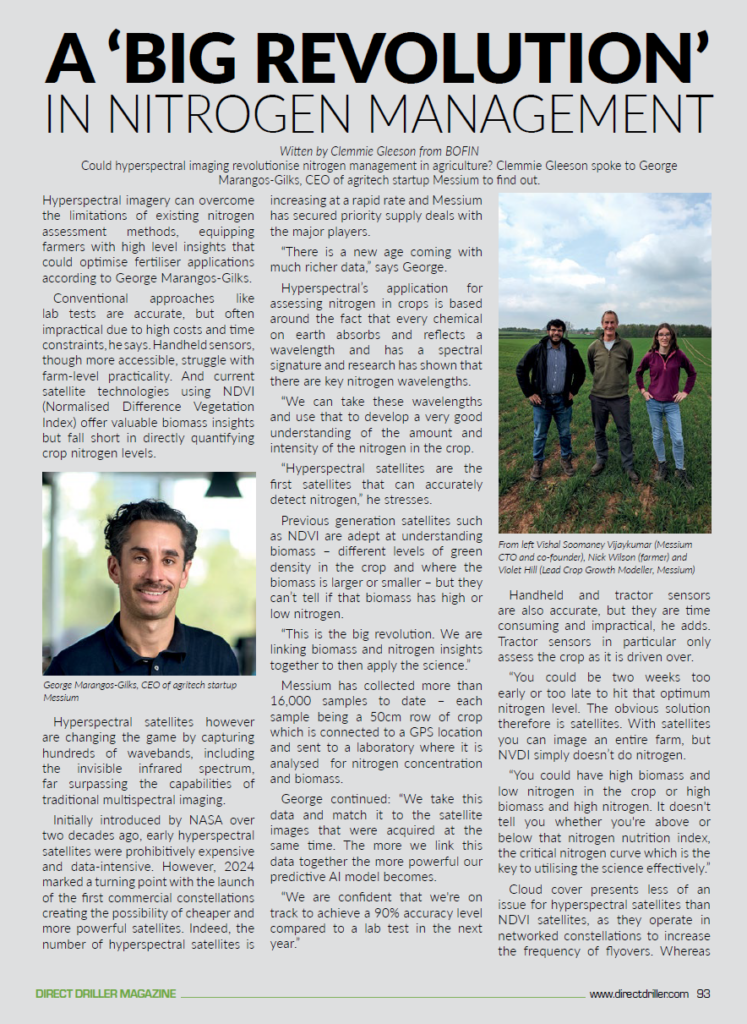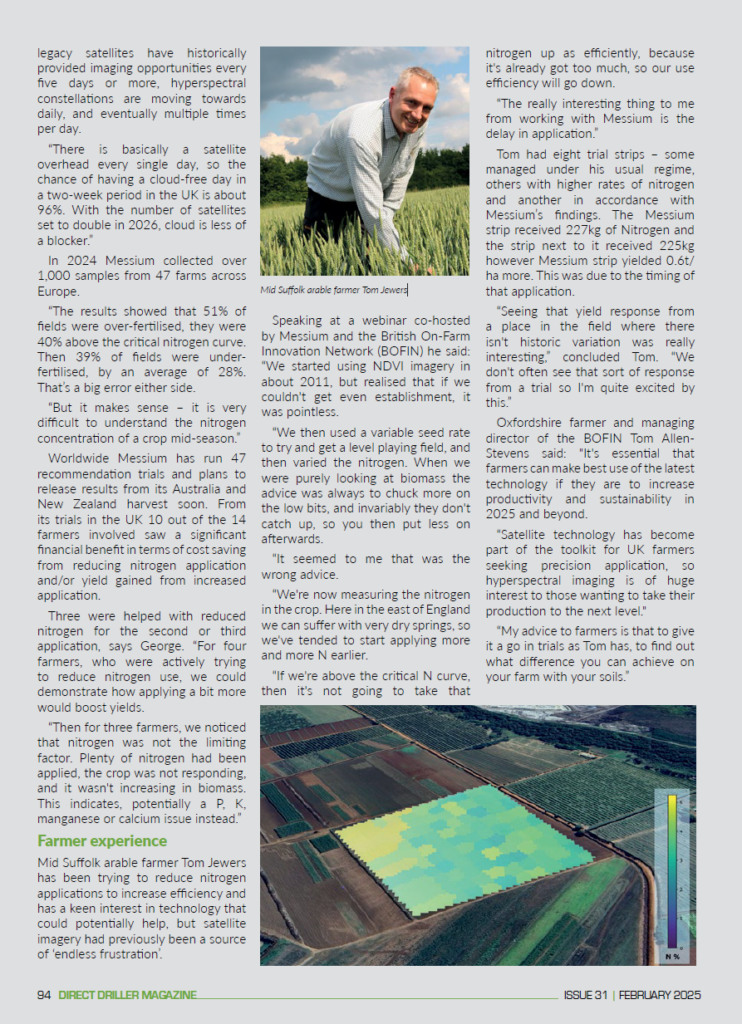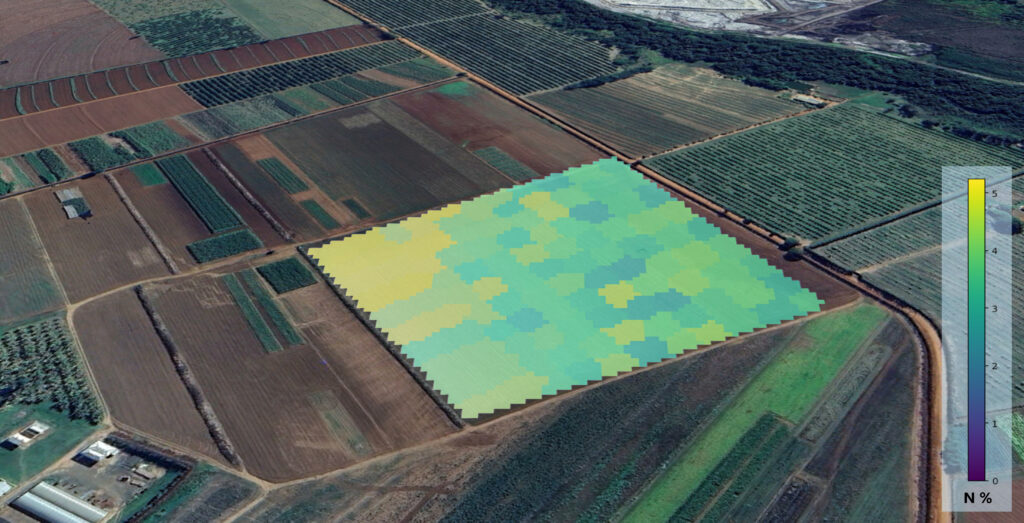Written by Clemmie Gleeson from BOFIN
Could hyperspectral imaging revolutionise nitrogen management in agriculture? Clemmie Gleeson spoke to George Marangos-Gilks, CEO of agritech startup Messium to find out.
Hyperspectral imagery can overcome the limitations of existing nitrogen assessment methods, equipping farmers with high level insights that could optimise fertiliser applications according to George Marangos-Gilks.
Conventional approaches like lab tests are accurate, but often impractical due to high costs and time constraints, he says. Handheld sensors, though more accessible, struggle with farm-level practicality. And current satellite technologies using NDVI (Normalised Difference Vegetation Index) offer valuable biomass insights but fall short in directly quantifying crop nitrogen levels.
Hyperspectral satellites however are changing the game by capturing hundreds of wavebands, including the invisible infrared spectrum, far surpassing the capabilities of traditional multispectral imaging.
Initially introduced by NASA over two decades ago, early hyperspectral satellites were prohibitively expensive and data-intensive. However, 2024 marked a turning point with the launch of the first commercial constellations creating the possibility of cheaper and more powerful satellites. Indeed, the number of hyperspectral satellites is increasing at a rapid rate and Messium has secured priority supply deals with the major players.
“There is a new age coming with much richer data,” says George.
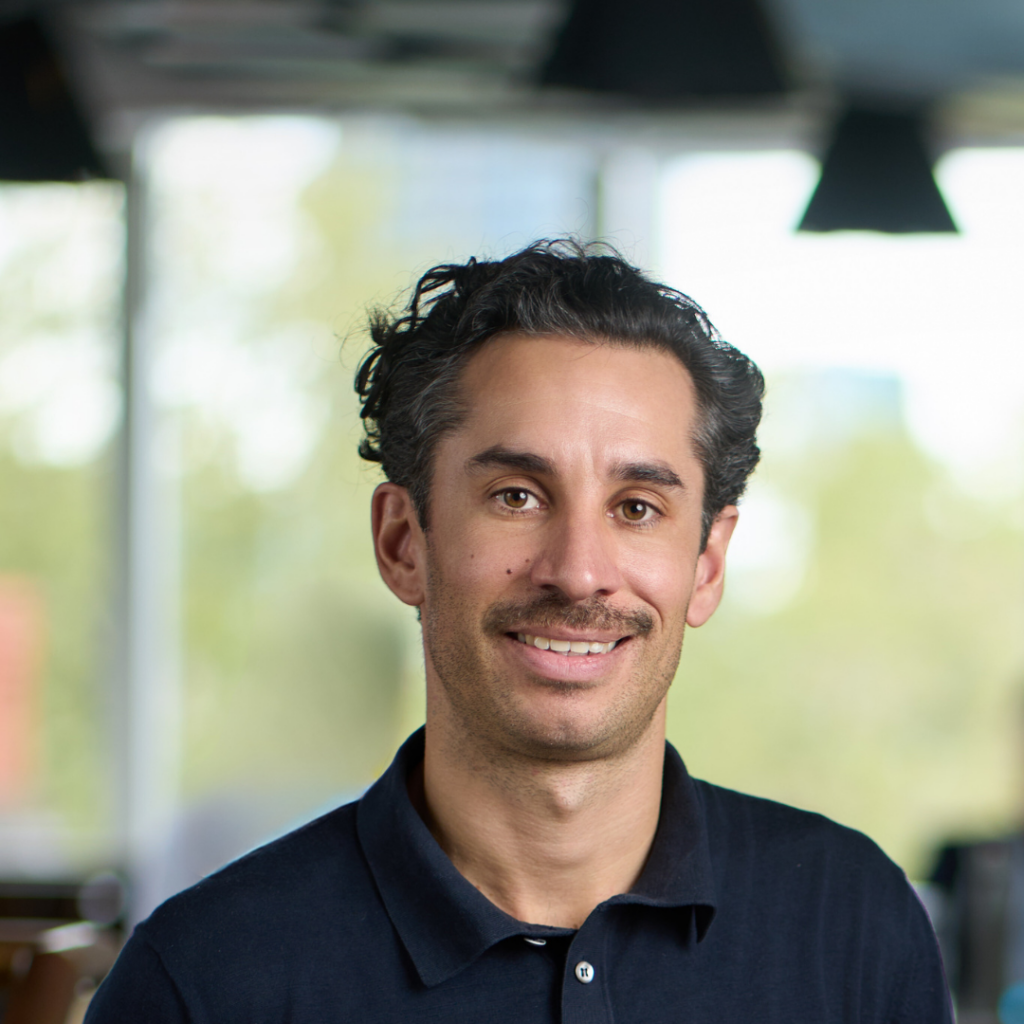
Hyperspectral’s application for assessing nitrogen in crops is based around the fact that every chemical on earth absorbs and reflects a wavelength and has a spectral signature and research has shown that there are key nitrogen wavelengths.
“We can take these wavelengths and use that to develop a very good understanding of the amount and intensity of the nitrogen in the crop.
“Hyperspectral satellites are the first satellites that can accurately detect nitrogen,” he stresses.
Previous generation satellites such as NDVI are adept at understanding biomass – different levels of green density in the crop and where the biomass is larger or smaller – but they can’t tell if that biomass has high or low nitrogen.
“This is the big revolution. We are linking biomass and nitrogen insights together to then apply the science.”
Messium has collected more than 16,000 samples to date – each sample being a 50cm row of crop which is connected to a GPS location and sent to a laboratory where it is analysed for nitrogen concentration and biomass.
George continued: “We take this data and match it to the satellite images that were acquired at the same time. The more we link this data together the more powerful our predictive AI model becomes.
“We are confident that we’re on track to achieve a 90% accuracy level compared to a lab test in the next year.”
Handheld and tractor sensors are also accurate, but they are time consuming and impractical, he adds. Tractor sensors in particular only assess the crop as it is driven over.
“You could be two weeks too early or too late to hit that optimum nitrogen level. The obvious solution therefore is satellites. With satellites you can image an entire farm, but NVDI simply doesn’t do nitrogen.
“You could have high biomass and low nitrogen in the crop or high biomass and high nitrogen. It doesn’t tell you whether you’re above or below that nitrogen nutrition index, the critical nitrogen curve which is the key to utilising the science effectively.”
Cloud cover presents less of an issue for hyperspectral satellites than NDVI satellites, as they operate in networked constellations to increase the frequency of flyovers. Whereas legacy satellites have historically provided imaging opportunities every five days or more, hyperspectral constellations are moving towards daily, and eventually multiple times per day.
“There is basically a satellite overhead every single day, so the chance of having a cloud-free day in a two-week period in the UK is about 96%. With the number of satellites set to double in 2026, cloud is less of a blocker.”
In 2024 Messium collected over 1,000 samples from 47 farms across Europe.
“The results showed that 51% of fields were over-fertilised, they were 40% above the critical nitrogen curve. Then 39% of fields were under-fertilised, by an average of 28%. That’s a big error either side.
“But it makes sense – it is very difficult to understand the nitrogen concentration of a crop mid-season.”
Worldwide Messium has run 47 recommendation trials and plans to release results from its Australia and New Zealand harvest soon. From its trials in the UK 10 out of the 14 farmers involved saw a significant financial benefit in terms of cost saving from reducing nitrogen application and/or yield gained from increased application.
Three were helped with reduced nitrogen for the second or third application, says George. “For four farmers, who were actively trying to reduce nitrogen use, we could demonstrate how applying a bit more would boost yields.
“Then for three farmers, we noticed that nitrogen was not the limiting factor. Plenty of nitrogen had been applied, the crop was not responding, and it wasn’t increasing in biomass. This indicates, potentially a P, K, manganese or calcium issue instead.”
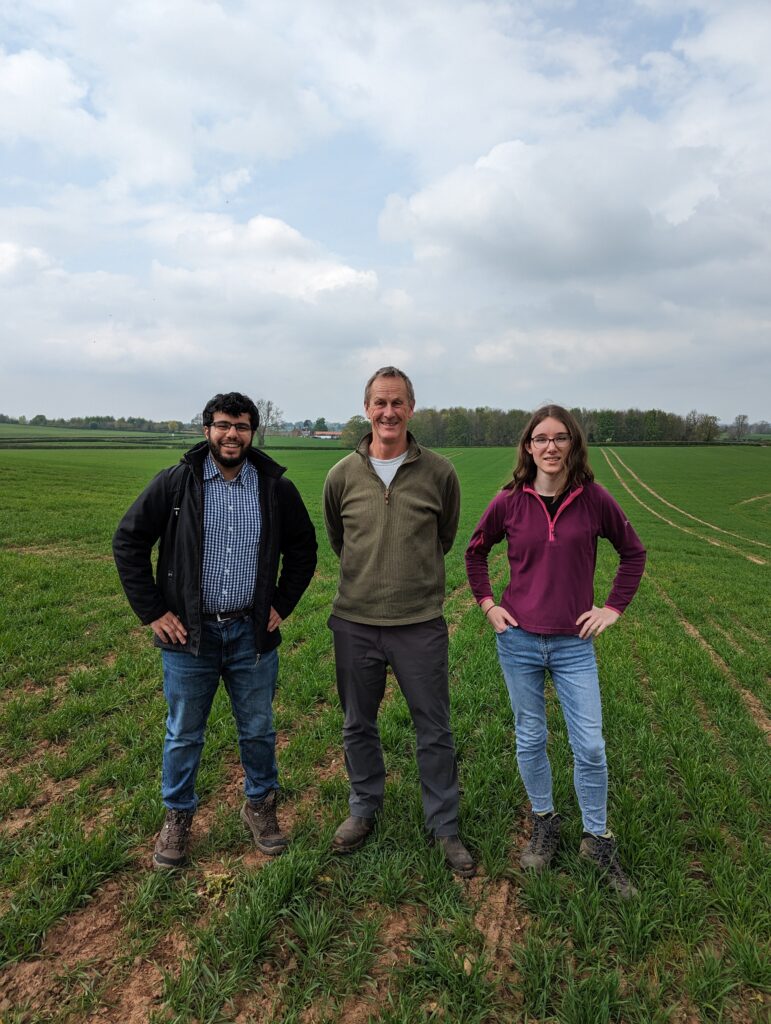
Farmer experience
Mid Suffolk arable farmer Tom Jewers has been trying to reduce nitrogen applications to increase efficiency and has a keen interest in technology that could potentially help, but satellite imagery had previously been a source of ‘endless frustration’.
Speaking at a webinar co-hosted by Messium and the British On-Farm Innovation Network (BOFIN) he said: “We started using NDVI imagery in about 2011, but realised that if we couldn’t get even establishment, it was pointless.
“We then used a variable seed rate to try and get a level playing field, and then varied the nitrogen. When we were purely looking at biomass the advice was always to chuck more on the low bits, and invariably they don’t catch up, so you then put less on afterwards.
“It seemed to me that was the wrong advice.
“We’re now measuring the nitrogen in the crop. Here in the east of England we can suffer with very dry springs, so we’ve tended to start applying more and more N earlier.
“If we’re above the critical N curve, then it’s not going to take that nitrogen up as efficiently, because it’s already got too much, so our use efficiency will go down.
“The really interesting thing to me from working with Messium is the delay in application.”
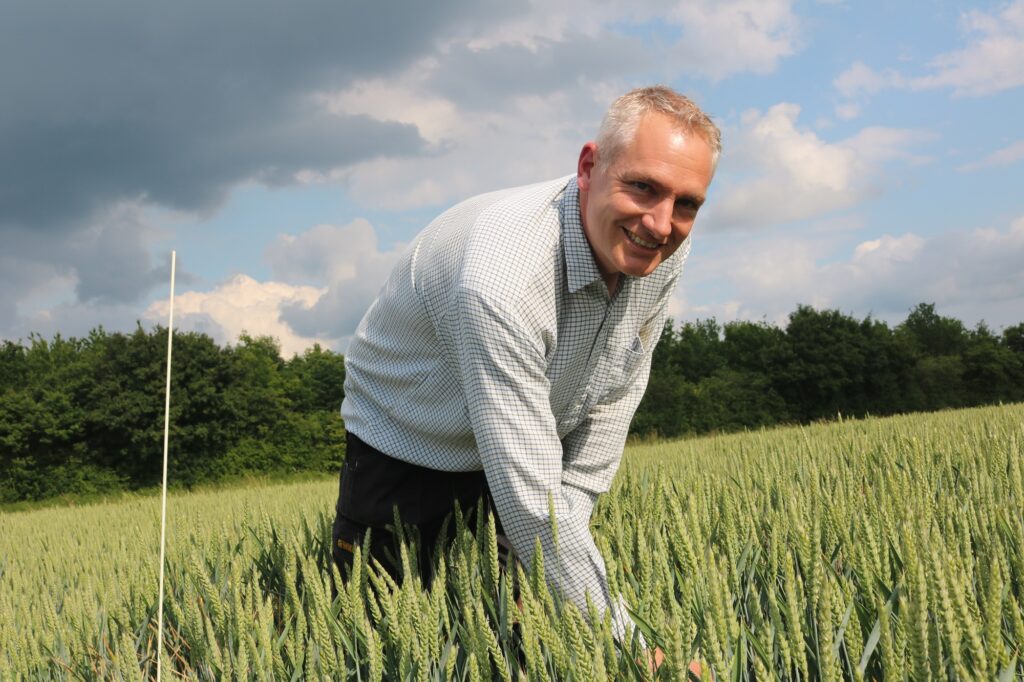
Tom had eight trial strips – some managed under his usual regime, others with higher rates of nitrogen and another in accordance with Messium’s findings. The Messium strip received 227kg of Nitrogen and the strip next to it received 225kg however Messium strip yielded 0.6t/ha more. This was due to the timing of that application.
“Seeing that yield response from a place in the field where there isn’t historic variation was really interesting,” concluded Tom. “We don’t often see that sort of response from a trial so I’m quite excited by this.”
Oxfordshire farmer and managing director of the BOFIN Tom Allen-Stevens said: “It’s essential that farmers can make best use of the latest technology if they are to increase productivity and sustainability in 2025 and beyond.
“Satellite technology has become part of the toolkit for UK farmers seeking precision application, so hyperspectral imaging is of huge interest to those wanting to take their production to the next level.” “My advice to farmers is that to give it a go in trials as Tom has, to find out what difference you can achieve on your farm with your soils.”
